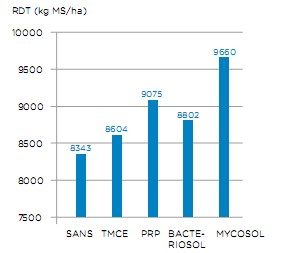18 June 2012
Potential of Soil Microbial Activity Stimulants in Pasture
Pasture accumulates large amounts of organic matter in the top soil horizon. Although this plays a positive part to mitigate CO2 concentrations increase in the atmosphere, it may be advantageous to stimulate mineralisation so as to make various nutrients available to the cover in situ and to limit the need for fertiliser.
After three years of monitoring it has to be said that, compared with an untreated control, the test products did not succeed in curbing the fall in soil phosphorus and potassium levels caused by their removal in successive hay harvests. Nevertheless, as the graph illustrates, an increase of the average yield of 1,300 kg DM/ha was observed with application of Mycosol in comparison to the control, with no impact on the quality of the biomass harvested. Among the organic conditioner based products the outstanding one was Mycosol, containing about 12% potassium and 7% nitrogen, whereas PRP, which contains little of these elements, seems useful for liming purposes. These effects were apparent whether or not nitrogen was applied, and less marked after the application of organic fertilizer (manure). But are these results economically viable? Taking into account the cost of the materials, the cost per tonne of additional dry matter harvested is 100, 260, 340 and over 500 euros with Mycosol, PRP, Bacteriosol and TMCE, respectively. So this needs further thought: depending on the interest from the farmers, these experiments could be repeated with a moderate application of phosphorus-potassium fertilizer to establish whether these effects are confirmed under such conditions.
This project was subsidised by the Regional Government of Wallonia, Department of Agriculture, Natural Resources and the Environment, Development and Extension Section.

